
Yoga is a group of physical, mental, and spiritual practices or disciplines which originated in ancient India and aim to control (yoke) and still the mind, recognizing a detached witness-consciousness untouched by the mind (Chitta) and mundane suffering (Duḥkha). There is a wide variety of schools of yoga, practices, and goals in Hinduism, Buddhism, and Jainism, and traditional and modern yoga is practiced worldwide.

Iyengar Yoga, named after and developed by B. K. S. Iyengar, and described in his bestselling 1966 book Light on Yoga, is a form of yoga as exercise that has an emphasis on detail, precision and alignment in the performance of yoga postures (asanas).

A mat is a hard floor covering that generally is placed on a floor or other flat surface. Mats serve a range of purposes including:
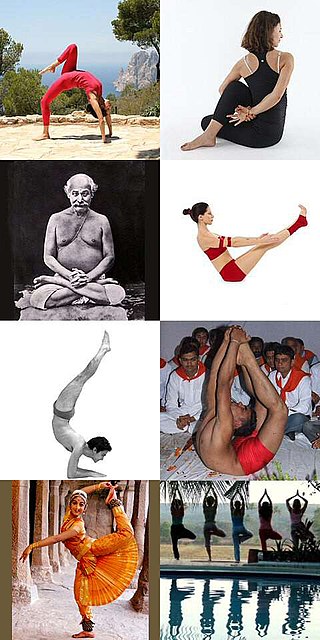
An āsana is a body posture, originally and still a general term for a sitting meditation pose, and later extended in hatha yoga and modern yoga as exercise, to any type of position, adding reclining, standing, inverted, twisting, and balancing poses. The Yoga Sutras of Patanjali define "asana" as "[a position that] is steady and comfortable". Patanjali mentions the ability to sit for extended periods as one of the eight limbs of his system. Asanas are also called yoga poses or yoga postures in English.

Pashchimottanasana, Seated Forward Bend, or Intense Dorsal Stretch is a seated forward-bending asana in hatha yoga and modern yoga as exercise. Janusirsasana is a variant with one knee bent out to the side; Upavishthakonasana has the legs straight and wide apart.
The Sanskrit word bhava (भव) means being, worldly existence, becoming, birth, be, production, origin, but also habitual or emotional tendencies.

Trikonasana or Utthita Trikonasana, [Extended] Triangle Pose is a standing asana in modern yoga as exercise. Variations include Baddha Trikonasana and Parivrtta Trikonasana.

Sivananda Yoga is a spiritual yoga system founded by Vishnudevananda; it includes the use of asanas but is not limited to them as in systems of yoga as exercise. He named this system, as well as the international Sivananda Yoga Vedanta Centres organization responsible for propagating its teachings, after his guru, Sivananda with the mission 'to spread the teachings of yoga and the message of world peace' which has since been refined to 'practice and teach the ancient yogic knowledge for health, peace, unity in diversity and self-realization.'
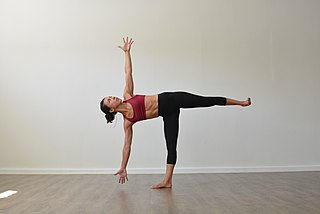
Ardha Chandrasana or Half Moon Pose is a standing asana in modern yoga as exercise.
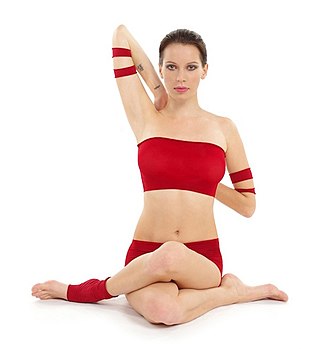
Gomukhasana or Cow Face Pose is a seated asana in hatha yoga and modern yoga as exercise, sometimes used for meditation.
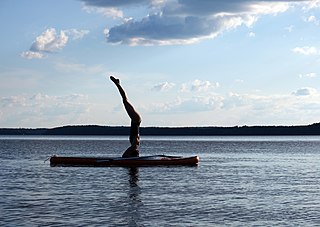
Paddleboard Yoga, invented by 2009, is the practice of modern yoga as exercise, and sometimes specific transitions between postures, while stand up paddleboarding, usually with the board in calm water, such as a lake. Beginners may practice this yoga hybrid on the beach or in a swimming pool to gain the strength and flexibility to maintain the balance necessary when the board is afloat. Beginners may practice a sequence of asanas either on a normal length surfboard or a specially designed stand up paddle board; some, described as "forgiving", are inflatable. Paddle board yoga is celebrated at the Wanderlust Festival in Hawaii. One of the pioneers of Paddleboard Yoga, Rachel Bråthén, lives and teaches yoga in the island of Aruba in the Caribbean Sea; she began teaching Paddleboard Yoga in 2009.

Yoga as exercise is a physical activity consisting mainly of postures, often connected by flowing sequences, sometimes accompanied by breathing exercises, and frequently ending with relaxation lying down or meditation. Yoga in this form has become familiar across the world, especially in the US and Europe. It is derived from medieval Haṭha yoga, which made use of similar postures, but it is generally simply called "yoga". Academics have given yoga as exercise a variety of names, including modern postural yoga and transnational anglophone yoga.
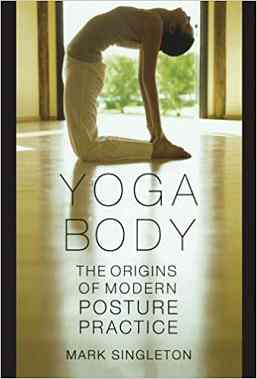
Yoga Body: The Origins of Modern Posture Practice is a 2010 book on yoga as exercise by the yoga scholar Mark Singleton. It is based on his PhD thesis, and argues that the yoga known worldwide is, in large part, a radical break from hatha yoga tradition, with different goals, and an unprecedented emphasis on asanas, many of them acquired in the 20th century. By the 19th century, the book explains, asanas and their ascetic practitioners were despised, and the yoga that Vivekananda brought to the West in the 1890s was asana-free. Yet, from the 1920s, an asana-based yoga emerged, with an emphasis on its health benefits, and flowing sequences (vinyasas) adapted from the gymnastics of the physical culture movement. This was encouraged by Indian nationalism, with the desire to present an image of health and strength.

Yoga Makaranda, meaning "Essence of Yoga", is a 1934 book on hatha yoga by the influential pioneer of yoga as exercise, Tirumalai Krishnamacharya. Most of the text is a description of 42 asanas accompanied by 95 photographs of Krishnamacharya and his students executing the poses. There is a brief account of practices other than asanas, which form just one of the eight limbs of classical yoga, that Krishnamacharya "did not instruct his students to practice".

Yoga the Iyengar Way is a 1990 guide to Iyengar Yoga, a style of modern yoga as exercise, by the yoga teachers Silva Mehta and her children Mira Mehta and Shyam Mehta. They were among the first teachers to be trained by B. K. S. Iyengar outside India.
Angela Farmer is a teacher of modern yoga as exercise. She uses a non-lineage style that emphasizes the feminine, free-flowing aspect. She is known also as the creator of the first yoga mat.

The standing asanas are the yoga poses or asanas with one or both feet on the ground, and the body more or less upright. They are among the most distinctive features of modern yoga as exercise. Until the 20th century there were very few of these, the best example being Vrikshasana, Tree Pose. From the time of Krishnamacharya in Mysore, many standing poses have been created. Two major sources of these asanas have been identified: the exercise sequence Surya Namaskar ; and the gymnastics widely practised in India at the time, based on the prevailing physical culture.

A yoga brick or yoga block is a smooth block of wood or of firm but comfortable material, such as hard foam rubber or cork, used as a prop in yoga as exercise.

Props used in yoga include chairs, blocks, belts, mats, blankets, bolsters, and straps. They are used in postural yoga to assist with correct alignment in an asana, for ease in mindful yoga practice, to enable poses to be held for longer periods in Yin Yoga, where support may allow muscles to relax, and to enable people with movement restricted for any reason, such as stiffness, injury, or arthritis, to continue with their practice.






















